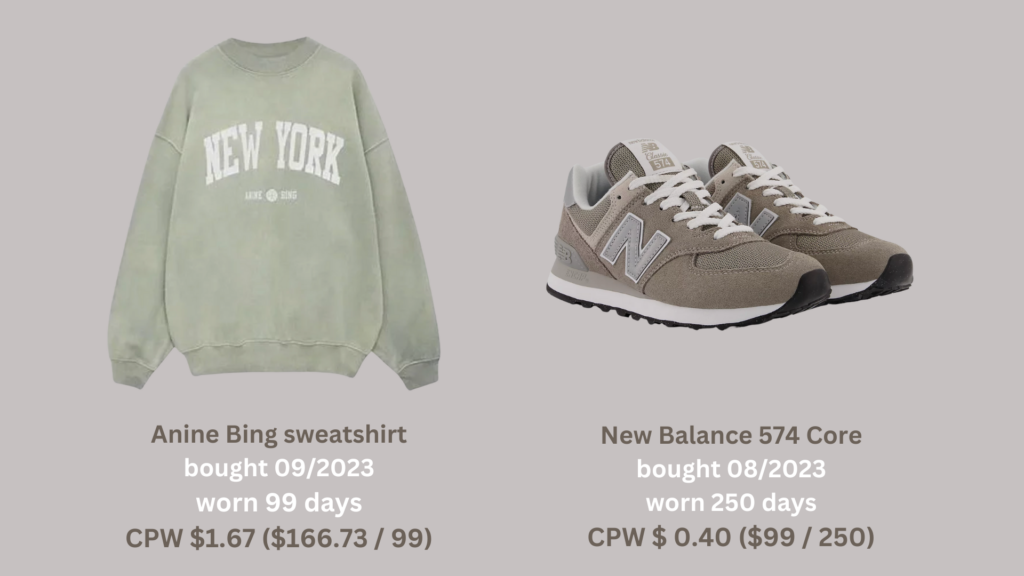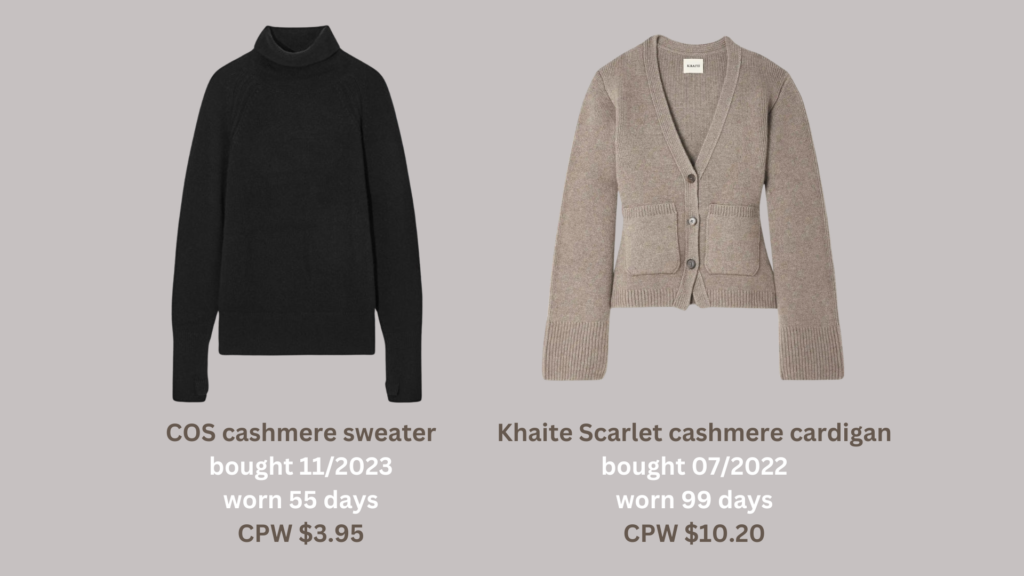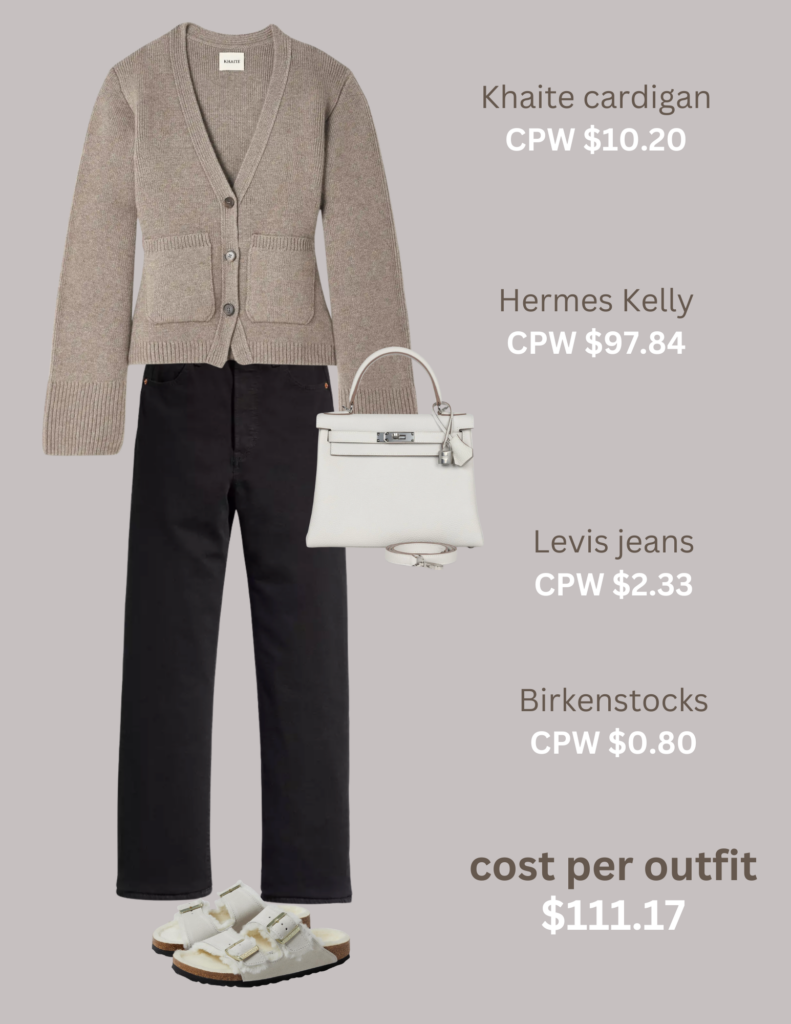2024 was a rough year in more ways than one. I made an overwhelming amount of purchases, as well as returns. It had one thing going for it though; I somehow managed to channel my addictive inclinations productively, by consistently tracking my wardrobe and outfits every single day. And I fully credit this to the cost per wear feature in Stylebook. Yes, I am still hooked on it.
What is Cost per Wear?
Do you know how much you spend on clothing every day? How much do our outfits cost on average? Enter: cost per wear. Cost per wear means, quite literally, the monetary cost of an item each time it’s worn. Here are some reasons why some people believe it matters.
Cost per wear = price paid (usually price tag, plus tailoring)* / # times worn
* some add follow-on costs such as dry cleaning to this price

Despite it being a pretty intuitive concept, I never used to think about cost per wear. It’s interesting – a familiar calculation I routinely make with rent ($3,000/month means $100/day) and metro passes ($120/month means $4/day). But never with clothing or accessories. I’ve written about how fashion purchases had always seemed to elude my better judgment. I didn’t spend more than I could afford, but I didn’t spend mindfully either. I saw shopping as a hobby and hunted “bargains” for sport.
Before my intentionality journey, when I evaluated an item, $2,000 and $200 alike, the only economic question I asked myself was: Can I afford this? As long as it was within my budget (and I liked it enough, of course), it came home with me. After the brief high from walking out of a store holding a shopping bag, it was so easy to shove a bad purchase to the back of the closet. Since I was financially comfortable, it was equally easy, and convenient, to not scrutinize or keep track of the money I’d flushed down the toilet. I had fun shopping, so money well spent, right?
It certainly felt so, until I was donating clothes with tags still on them. I could no longer turn a blind eye on my closet cluttered with clothes I had barely worn. But even then, it was just physical evidence of my mindless wastefulness in the abstract.
How I calculate and monitor cost per wear
Outfit tracking with the Stylebook app has become a staple in my quest for a mindful wardrobe. That means taking stock of every item in my closet (including its price) and recording what I wear everyday. One of the most compelling (and almost addictive) features of Stylebook is cost per wear for each logged item. Since starting to use the app, I have religiously, and frankly eagerly, been checking cost per wear, sometimes multiple times a day.

There is something so satisfying about seeing the cost per wear of my items go down. To me it’s similar to the feelings from seeing my bank account balances go up with every paycheck. I am also forced to confront how much money my wardrobe and outfits cost in concrete, digestible numbers. Some purchases immediately prove themselves to be workhorse pieces with rapidly dropping cost per wear, while others, such as luxury indulgences, linger at uncomfortably high numbers.

“Optimal” cost per wear – Fact or myth? Friend or foe?
So what is the magic number? Or is the point to just get cost per wear as low as possible? It differs for each of us, for each item. For me, the cost per wear for my Hermes Kelly bag will never be as low as that for the mid-range bag that I wore out in the 8 years when I didn’t have the resources for or focus on nice handbags. (To get the cost per wear of my Hermes Kelly 25 to the same amount, I’d need to wear it more than 24,000 times, that is, every single day for over 65 years.)
And that’s okay. Luxury purchases are called luxury for a reason. In deciding to buy an Hermes Kelly, I knew it was a beauty that oozes opulence, both in the way it looks and its price tag. Sometimes a girl just needs to indulge. And every single time I hold the Kelly in my hands, I feel like a (modern day) princess and it elevates whatever I’m wearing.
The same goes for that edgy Martin Margiela x H&M maxi dress. I will never be able to get its cost per wear down as low as a basic tank top I wear daily. There are simply not enough special occasions in the world for that. Even fewer for me. But every chance I get to put it on, it puts a smile on my face and invites compliments that make my day.
The optimal cost per wear is therefore whatever makes us feel good. Not moment-of-the-impulse-purchase good. Not guilty-pleasure good. Simply, good. It is what I would call “cost-per-wear peace;” when we’re at peace with an item as well as the price we paid for it. It is that number when an item is well-loved, either because we wear it to death or because it is that go-to piece for rare occasions but which embodies our style, essence, and confidence.
Manipulating cost per wear?
Now, for most of my items, it is hard to say whether I’m at cost-per-wear peace. Rather, as mentioned before, I love the chase. The chase of a diminishing cost per wear, that is. And somehow my lifestyle presents me with an opportunity. A shortcut of sorts.
I work from home (in other words, I get to dress very comfortably for work). I take a couple of short walks each day, to daycare and for lunch. So if I wanted to, I could do three outfit changes in a day, to accelerate the drop in my cost per wear. If I was going to change clothes anyway, between the walks and work, why not change into whatever I want, if that means a different outfit each time? Between the temperature swings and different destinations, a different outfit makes sense, right? And I did that for a while.
Then I caught myself. A smaller numerical number means nothing if I knew I cheated. It would not bring peace. Being able to say that the cost per wear for my Kelly was $50 as opposed to $100 would’ve sounded cool, but I don’t need to sound cool to anyone but myself. So honesty is key – is a $50 cost per wear really better than $100, if that “wear” means wearing it for 20 minutes and not hours?
Instead of racing to the bottom of cost per wear, I gave myself another challenge. A challenge to stick with the same items in a day as much as possible. I started playing and experimenting with my pieces, mixing and matching in previously unexpected ways. More importantly, I found joy in doing that, and in knowing that now, one “wear” could represent creative uses in multiple outfits in a day. And that, feels good.
How cost per wear is transforming my wardrobe
Oddly enough, I find it difficult to swallow the notion of spending $44.71 to wear a Valentino cardigan with fur once, even though it was a pretty easy decision to buy it for $268.31. The construct of cost per wear, and more importantly the actual numbers for my pieces, gives me a brand new, much-needed perspective on how to think about the cost of my wardrobe and shopping habits. Nowadays, sometimes just the thought that an item might have a high cost per wear for an unbearably long time is enough to stop me from making the purchase in the first place.
Tracking cost per wear has helped me be more intentional with my purchases and my outfits.
Try it.
xo